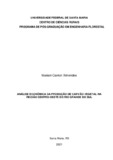| dc.creator | Ximendes, Mariani Carrion | |
| dc.date.accessioned | 2021-08-11T18:43:47Z | |
| dc.date.available | 2021-08-11T18:43:47Z | |
| dc.date.issued | 2021-05-12 | |
| dc.identifier.uri | http://repositorio.ufsm.br/handle/1/21900 | |
| dc.description.abstract | The present study verified the economic viability of the production of charcoal for barbecue in the Midwest region of Rio Grande do Sul, from the forno-fornalha System, in addition to proposing the expansion of the forest base in the region for the supply of wood for production of charcoal through Silvipastoril System of triple lines. The data used for the analysis were the consumption of charcoal from the residential and commercial sectors, made available by the last Energy Balance of Rio Grande do Sul (BERS), number of households in the region at the Brazilian Institute of Geography and Statistics (IBGE) and number of commercial establishments (restaurants and steakhouses), available at the Ministry of Labor and Employment - MTE and areas with pastures made available by the IBGE Agricultural Census. Based on these data, the demand for charcoal in the region was estimated and further analysis of the economic viability of producing coal in a forno-fornalha system in the region under study. The financial criteria used were the Net Present Value (NPV), the Benefit-Cost Ratio (B / C), the Average Production Cost (CMPr) and the Annual Equivalent Value (VAE). The attractiveness rate adopted was 4% per year. The study shows a demand in the region for charcoal of 4,534,591.85 kg / year, which is not fully met by regional producers. The charcoal production for proposed 6- years scenario indicated a positive NPV of R$ 348,521.56, a B/C ratio of R$ 1.22, a CMPr of 1.84 and a VAE of R$ 65,807.24, indicating the viability of the project. The study also shows a potential for expansion of the forest base in the region of 567,232 hectares, which can be converted into Silvipastoril System for the production of wood to be transformed into charcoal. In conclusion, the region has the potential to produce charcoal in a sustainable and economically viable manner. | eng |
| dc.language | por | por |
| dc.publisher | Universidade Federal de Santa Maria | por |
| dc.rights | Attribution-NonCommercial-NoDerivatives 4.0 International | * |
| dc.rights.uri | http://creativecommons.org/licenses/by-nc-nd/4.0/ | * |
| dc.subject | Biomassa florestal | por |
| dc.subject | Critérios financeiros | por |
| dc.subject | Energia da biomassa | por |
| dc.subject | Forest biomass | eng |
| dc.subject | Financial criterion | eng |
| dc.subject | Biomass energy | eng |
| dc.title | Análise econômica da produção de carvão vegetal na região centro-oeste do Rio Grande do Sul | por |
| dc.title.alternative | Economic analysis of charcoal production in the central-west region of Rio Grande do Sul | eng |
| dc.type | Dissertação | por |
| dc.description.resumo | O presente estudo verificou a viabilidade econômica da produção de carvão vegetal para churrasco na região Centro-Oeste do Rio Grande do Sul, a partir do Sistema forno-fornalha, além de propor a expansão da base florestal da região para o fornecimento de madeira para produção de carvão vegetal através de Sistema Silvipastoril de linhas triplas. Os dados utilizados para a análise foram o consumo de carvão vegetal dos setores residencial e comercial, disponibilizado pelo último Balanço Energético do Rio Grande do Sul (BERS), número de domicílios da região no Instituto Brasileiro de Geografia e Estatística (IBGE) e número de estabelecimentos comerciais (restaurantes e churrascarias), disponíveis no Ministério do Trabalho e Emprego - MTE e as áreas com pastagens disponibilizadas pelo Censo Agropecuário do IBGE. A partir desses dados foi estimada a demanda de carvão vegetal da região e posterior análise da viabilidade econômica da produção de carvão em sistema forno-fornalha na região de estudo. Os critérios financeiros utilizados foram o Valor Presente Líquido (VPL), a Razão Benefício-Custo (B/C), o Custo Médio de Produção (CMPr) e o Valor Anual Equivalente (VAE). A taxa de atratividade adotada foi de 4% ao ano. O estudo mostra uma demanda da região por carvão vegetal de 4.534.591,85 kg/ano, que não é totalmente suprida por produtores regionais. A produção de carvão vegetal para o cenário proposto de 6 anos indicou um VPL positivo de R$ 348.521,56, razão B/C de R$ 1,22, CMPr de 1,84 e VAE de R$ 65.807,24, indicando a viabilidade do projeto. O estudo também mostra um potencial de expansão da base florestal da região de 567.232 hectares, que podem ser convertidos em Sistema Silvipastoril para a produção de madeira a ser transformada em carvão vegetal. Conclui-se que a região tem potencial para produzir carvão vegetal de maneira sustentável e economicamente viável. | por |
| dc.contributor.advisor1 | Farias, Jorge Antonio de | |
| dc.contributor.advisor1Lattes | http://lattes.cnpq.br/9537008908546721 | por |
| dc.contributor.advisor-co1 | Pedrazzi, Cristiane | |
| dc.contributor.referee1 | Geremia, Fabiano | |
| dc.contributor.referee2 | Simioni, Flávio José | |
| dc.creator.Lattes | http://lattes.cnpq.br/3076113384604406 | por |
| dc.publisher.country | Brasil | por |
| dc.publisher.department | Recursos Florestais e Engenharia Florestal | por |
| dc.publisher.initials | UFSM | por |
| dc.publisher.program | Programa de Pós-Graduação em Engenharia Florestal | por |
| dc.subject.cnpq | CNPQ::CIENCIAS AGRARIAS::RECURSOS FLORESTAIS E ENGENHARIA FLORESTAL | por |
| dc.publisher.unidade | Centro de Ciências Rurais | por |



